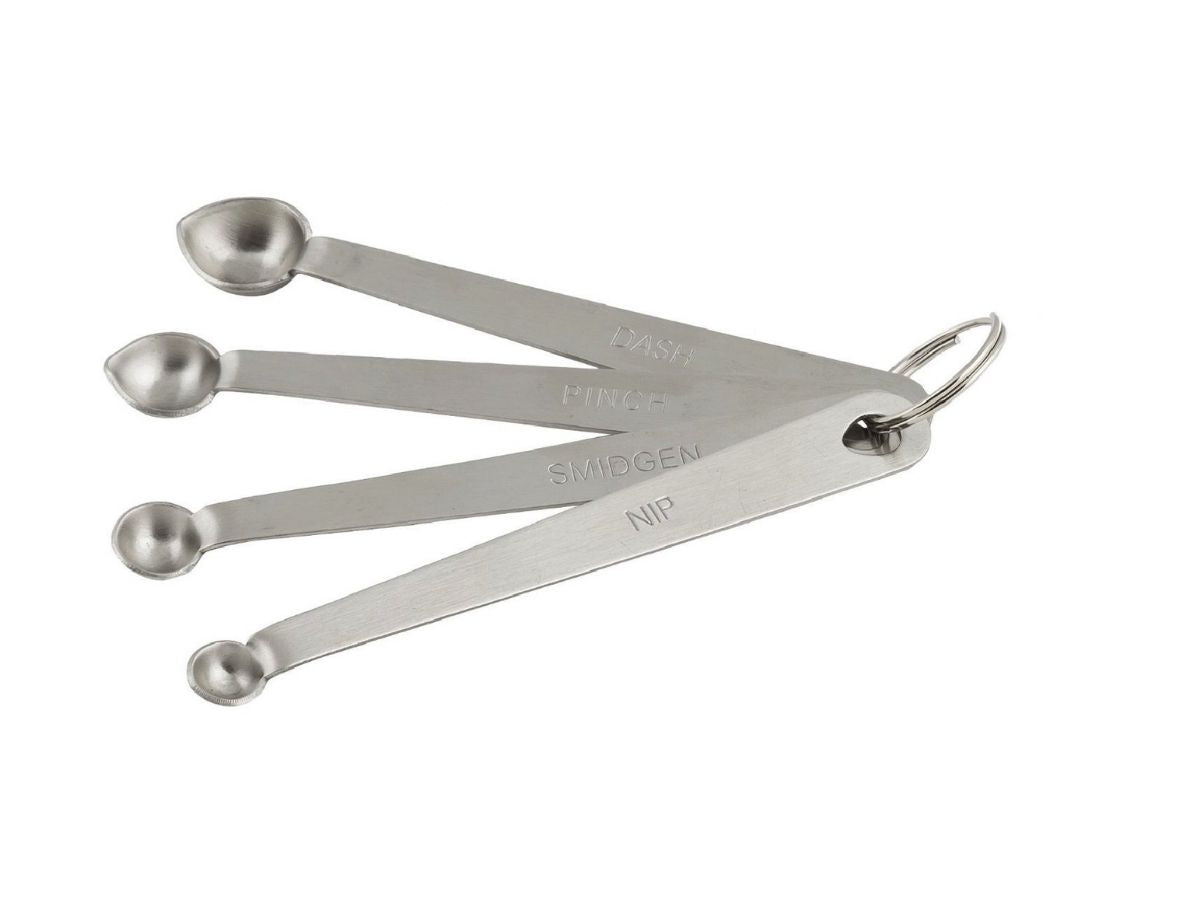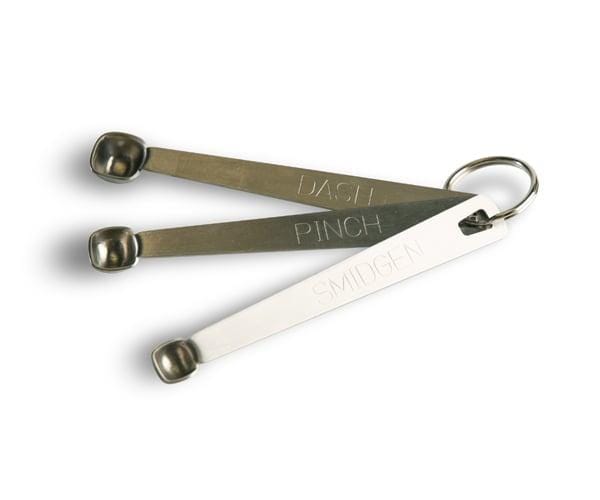Measuring small quantities of ingredients can be tricky. A pinch, a dash, or a smidgen—what do these terms mean?
Cooking often requires precise measurements. But sometimes, recipes call for a pinch or a dash. These small quantities can confuse even experienced cooks. Understanding these terms helps you cook better. In this guide, we will explain how to measure these tiny amounts.
You will learn the differences between them. This knowledge will make your cooking easier and more enjoyable. So, let’s get started with the basics of measuring those tiny, yet important, ingredients.
Introduction To Small Quantity Measurements
Measuring small quantities of ingredients is essential for accurate cooking. These small measurements, like a pinch or a dash, can make a big difference in the final taste of a dish. They may seem insignificant, but they ensure your recipes turn out just right. Knowing how to measure them can improve your cooking skills and bring consistency to your dishes.
Importance In Cooking
Small measurements are crucial for balancing flavors. A pinch of salt can enhance the taste. A dash of spice can add a needed kick. These tiny amounts can change the entire profile of a dish. Getting them right helps you achieve the perfect blend of flavors. It ensures your dish is neither too bland nor too overpowering.
In baking, precision is vital. Small measurements, like a pinch of baking soda, affect the texture. Too much or too little can ruin a batch of cookies. Accurate small measurements help you avoid common cooking mistakes. They lead to more predictable and tasty results.
Common Small Measurements
Several small measurements are commonly used in recipes. A pinch is usually between 1/16 and 1/8 of a teaspoon. It is what you can hold between your thumb and finger. A dash is a bit more than a pinch, roughly 1/8 of a teaspoon. A smidgen is even smaller than a pinch, about 1/32 of a teaspoon.
There are other small measurements like a drop. A drop is literally a single drop of liquid. These tiny amounts are often used in recipes for strong flavors. For example, vanilla extract or hot sauce. Understanding these measurements helps ensure you use the right amount.
Using the correct small measurements is key to successful recipes. It ensures you do not overpower or under-season your dishes. Keep these small measurement guidelines in mind. They can help you become a more precise and effective cook.
Pinch Measurement
Measuring small quantities of ingredients can seem tricky. A common small quantity is a pinch. Understanding how to measure a pinch accurately can enhance your cooking. It ensures your recipes turn out just right. Let’s dive into what a pinch measurement is and how to use it in recipes.
Definition Of A Pinch
A pinch is a small amount of an ingredient. It’s the amount you can hold between your thumb and forefinger. This usually measures around 1/16 of a teaspoon. It’s not an exact science. But, it works well for ingredients like salt, spices, or herbs.
Using A Pinch In Recipes
Using a pinch in recipes is simple. Just take a small amount between your thumb and forefinger. Sprinkle it into your dish. This method works best for seasoning. It adds flavor without overpowering the dish. A pinch is often used in soups, sauces, and salads.
Some recipes call for “a pinch of salt.” This enhances the dish’s natural flavors. A pinch of spices can elevate a meal. It’s perfect for adding a hint of heat or aroma. Remember, a little goes a long way. Start with a pinch, then taste. You can always add more if needed.
Using a pinch measurement can make cooking easier. It helps you add just the right amount of flavor. So, next time you cook, try using a pinch. Your taste buds will thank you.
Dash Measurement
Hey friends, today I’m going to talk about something that might sound tiny but is super important for your cooking adventures: the dash measurement. You know when a recipe says to add a “dash” of something? It can be a bit confusing, right? But don’t worry. I’ll break it down for you. Let’s dive into what a dash means and when you should use it.
What Is A Dash?
So, what exactly is a dash? A dash is a very small amount of an ingredient. Think of it like a pinch, but even less precise. It’s often used for liquid ingredients. For example, imagine you’re adding a splash of lemon juice to your salad dressing. That’s a dash! Typically, a dash is about 1/8 of a teaspoon. But remember, it doesn’t have to be exact. Just a small amount will do.
When To Use A Dash
Now, when should you use a dash? Here are a few tips:
- Seasoning: When you want to add a little extra flavor without overpowering the dish. Think about adding a dash of hot sauce to your soup. Just a tiny bit can make a big difference.
- Adjusting Taste: If your dish needs a touch more of something, like vinegar or soy sauce, a dash is perfect. It lets you tweak the flavor without going overboard.
- Finishing Touch: Sometimes, recipes call for a dash of something at the end. A dash of salt or lemon juice can brighten up the final dish.
I recently asked my mom about her secret to perfect scrambled eggs. She said, “A dash of milk makes them creamy.” And you know what? She was right. Just a little bit goes a long way.
So, next time you see “a dash” in a recipe, you’ll know exactly what to do. Happy cooking!

Credit: www.amazon.com
Smidgen Measurement
Measuring small quantities of ingredients can be tricky. Especially for novice cooks. Terms like ‘pinch,’ ‘dash,’ and ‘smidgen’ often appear in recipes. But what do they really mean? Understanding these measurements ensures accurate and tasty results. This post focuses on the smallest of them all: the smidgen. Let’s dive in.
Understanding A Smidgen
A smidgen is a tiny amount of an ingredient. Smaller than a pinch or dash. It equals roughly 1/32 of a teaspoon. This measurement is not exact. It varies slightly between sources. But it’s always very small. Perfect for adding a hint of flavor without overpowering a dish.
Smidgen In Cooking
In cooking, a smidgen is useful for strong spices. Think cayenne pepper or nutmeg. Just a smidgen can elevate your dish. It gives just enough flavor. Without overwhelming other ingredients. Smidgens are also great for delicate recipes. Where precision is key.
Using a smidgen helps control the intensity. Especially in baking. Or when experimenting with new flavors. For those who love to cook, mastering smidgen measurements is a valuable skill. It ensures balanced and delicious results every time.
Measuring With Spoons
Measuring with spoons is crucial for small quantities of ingredients. It’s common to encounter terms like pinch, dash, and smidgen in recipes. These small amounts can affect the taste and texture of your dish. Using measuring spoons ensures accuracy and consistency. Let’s dive into the details of how to measure these tiny quantities effectively.
Types Of Measuring Spoons
There are different types of measuring spoons available. Standard measuring spoons usually come in sets. They include 1 tablespoon, 1 teaspoon, 1/2 teaspoon, and 1/4 teaspoon. Some sets also have smaller spoons for pinch, dash, and smidgen. These help in measuring very small amounts accurately.
Material matters too. Measuring spoons come in plastic, stainless steel, or silicone. Stainless steel spoons are durable and easy to clean. Plastic spoons are lightweight and affordable. Silicone spoons are flexible and often colorful. Choose the type that suits your needs best.
Converting Small Quantities
Understanding conversions is important for small quantities. A pinch is roughly 1/16 of a teaspoon. A dash is about 1/8 of a teaspoon. A smidgen is even smaller, around 1/32 of a teaspoon. Knowing these conversions helps in using the right amount of ingredients.
Sometimes recipes require conversion to larger quantities. For example, 8 pinches equal 1/2 teaspoon. This helps when scaling recipes up or down. Keep a conversion chart handy for quick reference. It makes the cooking process smoother and more accurate.

Credit: 194crafthouse.com
Using Your Fingers
Measuring small quantities of ingredients can be tricky. Especially with terms like a pinch or a dash. Using your fingers is a simple and effective way. This method helps you get the right amount without any fancy tools.
Finger Measurement Techniques
Your fingers can be great measuring tools. A pinch is usually the amount you can hold between your thumb and forefinger. A dash is a bit more. Use your thumb, forefinger, and middle finger together.
For a smidgen, use just the tip of your forefinger. These measurements are not precise, but they work well for cooking. They add flavor without overpowering the dish.
Tips For Accuracy
Accuracy matters in baking. But for cooking, these small quantities are flexible. Always start with a little. You can always add more if needed. Practice makes perfect. The more you use your fingers, the better you get.
Keep your fingers clean and dry. Moist fingers can hold more ingredients. This might change the flavor of your dish. Pay attention to how much you are using each time.
Digital Scales For Precision
Measuring small quantities of ingredients accurately is vital. Digital scales offer precision that traditional measuring spoons lack. With digital scales, you can measure tiny amounts like a pinch or dash accurately. This precision ensures your recipes turn out perfect every time.
Choosing A Digital Scale
Selecting the right digital scale is important. Look for a scale with a high level of sensitivity. This means it can measure very small quantities, even down to a fraction of a gram. Check that the scale has a tare function. This feature lets you zero out the weight of containers, giving you a precise measurement of your ingredients.
Weighing Small Ingredients
Place a small bowl on the scale and use the tare function. This will reset the scale to zero. Add your ingredient slowly until you reach the desired weight. For tiny amounts, use a spoon or tweezers. This helps you add the ingredient gradually, ensuring accuracy.
Digital scales with a backlit display are easier to read. This can be particularly useful in low-light conditions. Always handle the scale with care to maintain its precision. Keep it clean and store it properly to ensure it lasts long.

Credit: www.savoryspiceshop.com
Expert Tips And Tricks
Measuring small quantities of ingredients such as a pinch or dash can be tricky. Precision matters, especially in baking and cooking. Expert tips and tricks can help ensure accuracy and consistency in your dishes.
Chef Recommendations
Professional chefs often rely on their instincts. But for home cooks, some guidelines can be helpful. A pinch is typically 1/16 of a teaspoon. A dash is around 1/8 of a teaspoon. These are rough estimates, but they can help you get close to the intended amount.
Some chefs suggest using your fingers. For a pinch, use your thumb and index finger. For a dash, add your middle finger. This method works well for dry ingredients like salt or spices.
Avoiding Common Mistakes
One common mistake is using too much or too little. This can affect the taste and texture of your dish. Start small and add more if needed. You can always add, but you can’t take away.
Another mistake is not leveling your measurements. Ensure that your teaspoons and tablespoons are level. This helps maintain accuracy.
Lastly, avoid using the same spoon for different ingredients. This can cause cross-contamination. Use separate spoons for each ingredient.
Frequently Asked Questions
How Do You Measure A Small Amount Of Ingredients?
Use measuring spoons for small amounts of ingredients. Level off for accuracy. Digital scales work well for precise measurements.
How Are Small Amounts Of Ingredients Measured With Measuring?
Use measuring spoons for small amounts of ingredients. Level off the spoon for accuracy. For tiny amounts, use a pinch.
What Is Used For Measuring Small Exact Amounts Of Ingredients?
Measuring spoons and digital scales are used for measuring small exact amounts of ingredients. They ensure precision.
What Is The Tool Called To Measure Small Amounts Of Ingredients?
The tool used to measure small amounts of ingredients is called a kitchen scale. It ensures precise measurements.
Conclusion
Measuring small quantities can be tricky, but practice helps. Use these tips to get accurate amounts. Pinches, dashes, and smidgens bring flavor to your dishes. Remember, a little goes a long way. Keep experimenting in the kitchen. Enjoy the process and trust your taste buds.
Happy cooking!

Rakib Sarwar is a seasoned professional blogger, writer, and digital marketer with over 12 years of experience in freelance writing and niche website development on Upwork. In addition to his expertise in content creation and online marketing, Rakib is a registered pharmacist. Currently, he works in the IT Division of Sonali Bank PLC, where he combines his diverse skill set to excel in his career.
